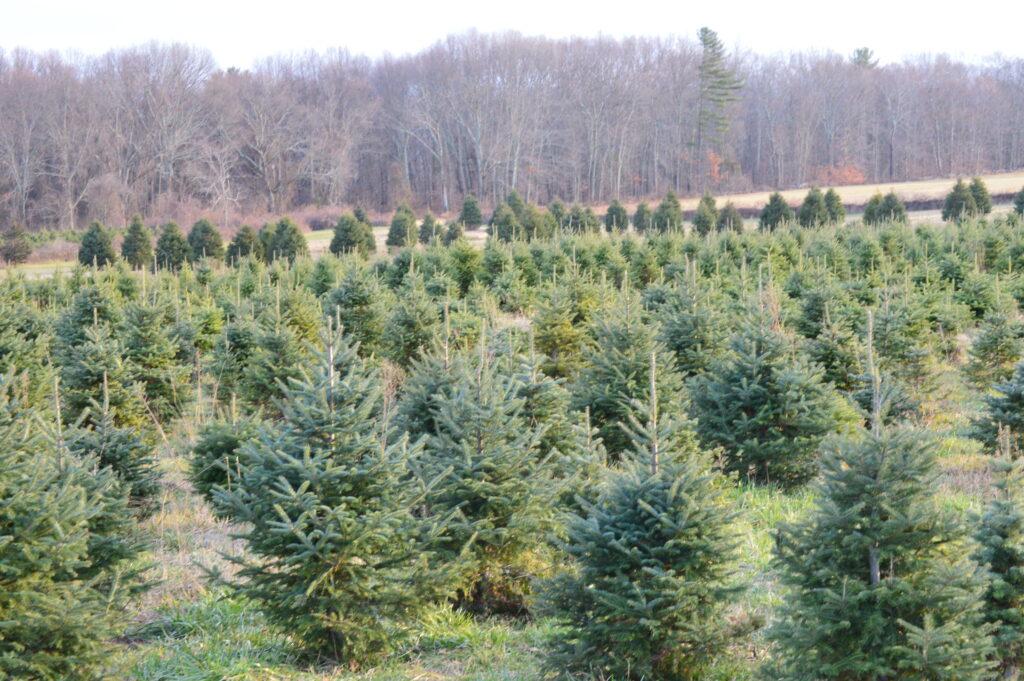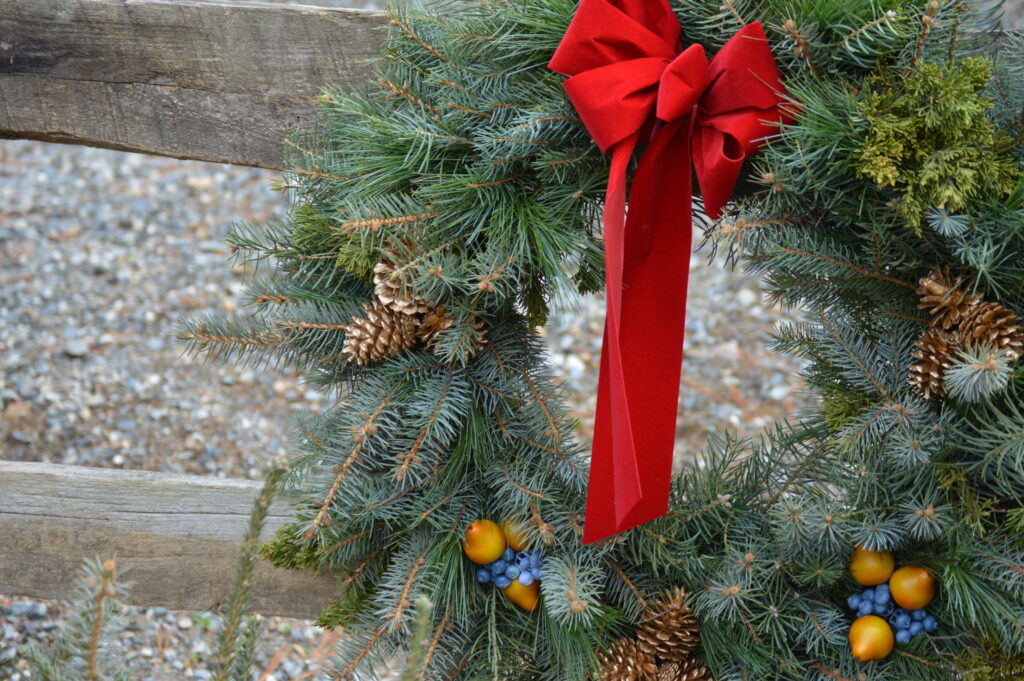
Christmas seems to arrive earlier each year. Store displays of yuletide decorations go up as soon as Halloween is over or sometimes even sooner.
While these Christmas displays may seem premature, this year they offer a helpful reminder to make plans to visit a CT Grown Christmas tree farm. Many farms have opened earlier than usual in anticipation of another year of strong demand for real Christmas trees.
The COVID-19 pandemic drove a spike of visitors to Christmas tree farms in 2020 and 2021, as people were more determined to create an enjoyable holiday experience at their home. Christmas tree farmers never could have anticipated this surge in demand, since growing a Christmas tree is a lengthy process; it takes five to 10 years for a seedling to reach maturity.
Farmers have to be cautious about how many Christmas trees are cut, since cutting too many immature trees in one season can have a ripple effect for years to come. Last year, some farms took steps such as shutting down early or restricting their cut-your-own options in order to prevent overharvesting. CT Grown farms expect a stronger inventory this year, but those who visit early will have more to choose from.
“We have plenty of beautiful trees and with more than 400 tree farms located throughout Connecticut, consumers will be able to find the perfect tree – folks should check the website or call ahead to check on availability,” said Commissioner Bryan P. Hurlburt of the Connecticut Department of Agriculture. “We encourage people to learn more about the varieties available, pick up a wreath, poinsettia, or other seasonal product to help decorate your home, and enjoy the special holiday celebrations going on at CT Grown Christmas tree farms.”
Can I pick out a tree now and cut it later?
Buying a Christmas tree requires careful timing; some farms allow tagging to choose a tree early and cut it later. Tagging enables you to visit the farm, select your tree, and place a tag on it. This tag lets farm staff and other visitors know that the tree has been reserved and should not be harvested.
Check with the farm ahead of time to see if they allow tagging, since some farms only allow same-day harvesting.
What you’ll find at a CT Grown Christmas tree farm
Cut-your-own farms invite you to stroll through the stands of trees and find the perfect specimen for your home. They usually provide you with a saw to fell the tree and sleds or carts to tote it out of the fields for purchase. Farms also have special equipment to shake off loose needles and wrap up the tree, and staffers are often willing to help you secure the tree to your vehicle.
Farms may also sell a variety of other seasonal items, such as wreaths and poinsettias, as well as tree accessories like stands, garlands, and even commemorative ornaments.


Christmas tree farms don’t just want to sell you a product; they work to create a memorable and enjoyable experience your family will want to revisit year after year. On any given weekend, you might discover that the farm is offering hay rides, hosting food trucks, providing family photo sessions, serving seasonal refreshments like hot cocoa and sugar cookies, or bringing in Santa Claus for a visit.
CT Grown Christmas tree varieties
There are several varieties of Christmas tree that grow in Connecticut. This guide can help you decide which type will best suit your needs:
- Balsam Fir: A dark green tree with long-lasting needles and a distinct fragrance
- Blue Spruce: Distinguished by sharp needles, which necessitate careful handling but can be useful if you need to keep pets at bay; has strong branches and good needle retention, but is not very aromatic
- Canaan Fir: Has similar characteristics to balsam and Fraser firs, with good needle retention
- Concolor Fir: Known for its longer needles, good needle retention, and strong scent
- Douglas Fir: One of most popular Christmas tree options, with a dark green hue, dense branches, soft needles, and a lovely fragrance; its branches are less robust than other options, making them better suited for light ornaments
- Fraser Fir: Features a blue-green appearance, strong branches, good needle retention, and a pleasant aroma
- Norway Spruce: Dark green and well-shaped, but with poorer needle retention
- White Pine: A good choice for those in need of a taller tree, with soft needles and good needle retention; drawbacks include minimal scent and weaker branches
- White Spruce: Well-shaped with a bluish green color; needle retention isn’t as strong, but is better than other spruce options
Tips for tree selection and care
Before you head to a CT Grown Christmas tree farm, measure the height of the room where you’ll place the tree and the width of the doors you’ll use to get the tree inside. Bring along a measuring tape to make sure the tree you pick won’t be too large.
Contrary to what Clark Griswold says, you don’t have to be frozen from the waist down as part of the experience. Dress in warm, comfortable clothes that you’re willing to get dirty, and wear sturdy footwear. Check ahead to see if you need to bring your own saw, and it’s a good idea to bring your own rope or tie-downs to secure the tree for the trip home.
Look for a healthy tree that doesn’t have too many brown or shedding needles. Don’t discount a tree just because it has a flaw or two, such as an area with thinner branches. If you’ll be placing the tree against a wall or in a corner, you can easily conceal a portion of the tree that is less visually appealing.
Once home, be sure to water your tree regularly to prevent the tree from drying out, which will cause the needles to shed faster and create a potential fire risk. Never let the water line drop below the bottom of the trunk, since doing so will allow resin to seal off further water uptake. Check the water level each day, or get an automatic tree waterer to assist with this task.
What should I do with the tree after the holiday?
Many towns and cities schedule a day or two for curbside pickup of Christmas trees, or designate a site where trees can be picked up. These trees are then used for compost, mulch, or sand dune stabilization projects to benefit local parks and beaches.
You can also place your tree in the yard as a sanctuary for birds. Decorate it again with simple bird feeders made from pine cones, peanut butter, and birdseed to attract more feathered friends to your home.
Christmas trees are also sought after by farms. Goats, alpacas, chickens, and other animals enjoy browsing through the branches as an appetizer or enrichment activity as they seek other treats hidden between the boughs.
Check in with your local farm to see if they are accepting trees following the holiday. Just be sure to remove all ornaments and decorations, and don’t ever give them to animals without permission.